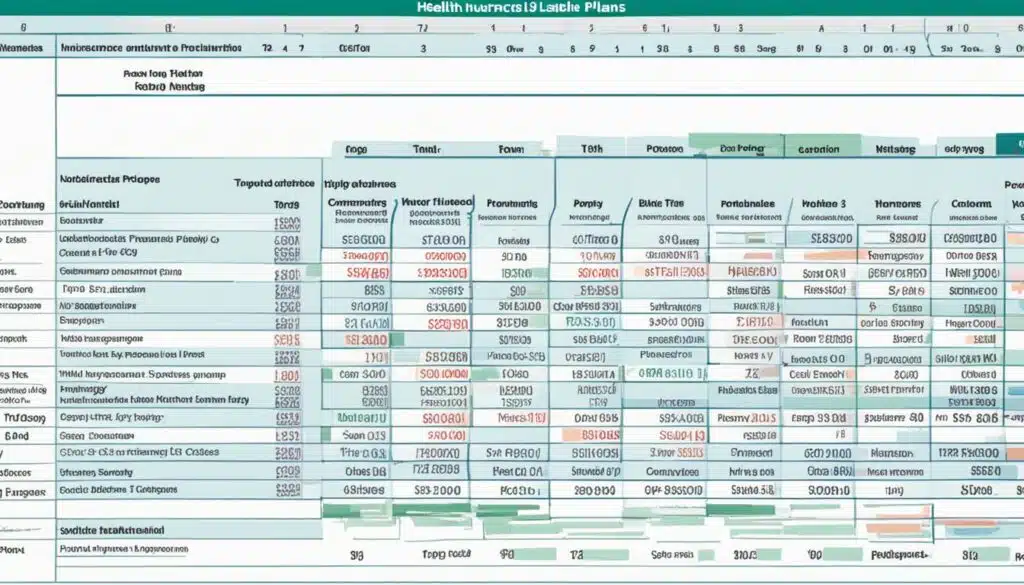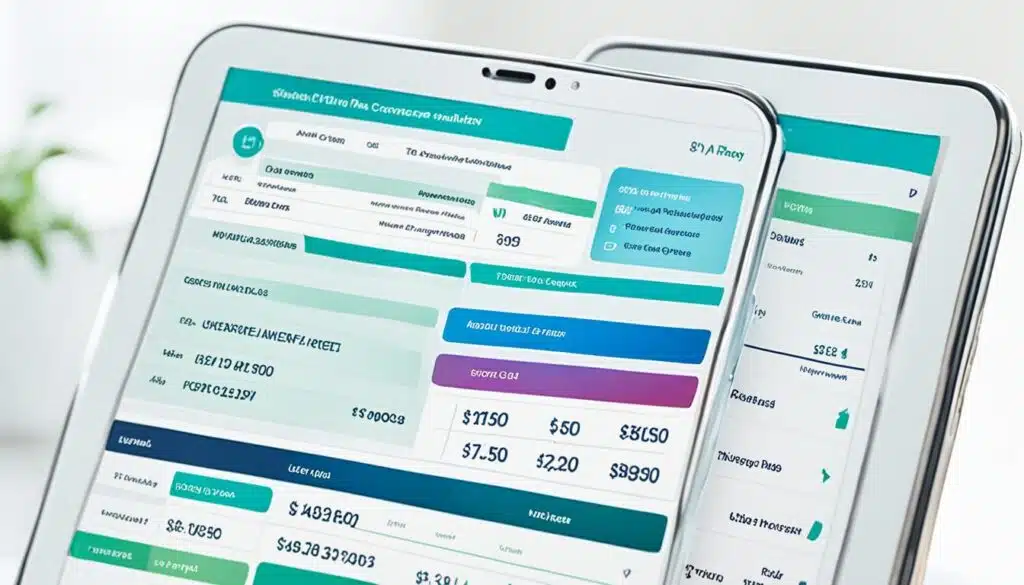Are you in search of wallet-friendly health insurance plans that provide comprehensive coverage without breaking the bank? Look no further! In this article, we will guide you on finding affordable and low-cost health insurance options that are budget-friendly and offer cost-effective health coverage.
When it comes to health insurance, cost is a major consideration. However, it doesn’t mean you have to compromise on the quality of coverage. By understanding your options and evaluating different healthcare plans, you can find the perfect balance between affordability and comprehensive coverage.
From deciphering health insurance terminology to exploring high deductible plans and health savings accounts, we will cover all the essential aspects of securing a wallet-friendly health insurance plan. We will also help you navigate the complexities of open enrollment and avoid common mistakes in health insurance selection.
So, if you’re ready to take control of your healthcare expenses and find the optimal health insurance plan that meets your needs and budget, let’s dive in!
Key Takeaways:
- Finding wallet-friendly health insurance is possible with proper research and evaluation.
- Understanding health insurance terminology and options is crucial for selecting the right plan.
- High deductible plans, paired with Health Savings Accounts (HSAs), can offer cost-effective solutions.
- Evaluate your healthcare needs and budget to select the optimal health insurance plan.
- Don’t forget to consider important deadlines and out-of-network coverage when making a decision.
Understanding Open Enrollment and Assessing Healthcare Plans
Open enrollment is a crucial period that allows individuals to enroll in or make changes to their health insurance plans. It’s essential to understand the process and evaluate different healthcare plans to ensure you have the right coverage. In this section, we’ll guide you through open enrollment and provide insights on assessing healthcare plans.
During the open enrollment period, you have the opportunity to review your current health insurance coverage and make adjustments if necessary. Whether you already have a plan or are looking for a new one, open enrollment is the time to explore your options and make informed decisions.
The Open Enrollment Timeline
The open enrollment period varies depending on the type of health insurance you have. Here are the common open enrollment timeframes:
- Individual & Family Health Insurance: The open enrollment period for individual and family health insurance plans typically begins in the late fall and lasts for a few weeks or months. It’s important to be aware of the specific dates set by your insurance provider or the state health insurance exchange.
- Medicare: If you’re eligible for Medicare, the open enrollment period is from October 15th to December 7th each year. During this time, you can review and make changes to your Medicare Part D prescription drug coverage or switch to a Medicare Advantage plan.
- Employer-Sponsored Health Insurance: Many employers offer a specific window for open enrollment. Check with your human resources department to find out the exact dates and any additional requirements.
It’s crucial to mark your calendar and be aware of the open enrollment period to ensure you have the opportunity to make changes as needed.
Evaluating Healthcare Plans
When assessing healthcare plans during open enrollment, consider the following factors:
- Coverage: Review the healthcare services covered by each plan, such as doctor visits, hospital stays, prescription drugs, and preventive care.
- Costs: Compare the premiums, deductibles, copayments, and out-of-pocket maximums of different plans to determine which fits your budget.
- Network: Check if your preferred doctors, specialists, and hospitals are included in the plan’s network. Out-of-network care may result in higher costs.
- Prescription Drugs: If you take regular medications, make sure the plan covers your prescription drugs and check the costs associated with them.
- Additional Benefits: Some plans offer additional benefits like dental and vision coverage or wellness programs. Evaluate these offerings based on your needs.
- Customer Satisfaction: Research customer reviews and ratings to gauge the satisfaction levels of current plan members.
By carefully evaluating these factors, you’ll be able to select a healthcare plan that meets your needs, aligns with your budget, and provides the necessary coverage.
Remember, open enrollment is your chance to make changes to your health insurance coverage, so take advantage of this period to ensure you have the appropriate healthcare plan for the upcoming year.
Deciphering Health Insurance Terminology and Options
Understanding the terminology used in health insurance is essential for making informed decisions about your coverage. In this section, we’ll break down common terms like deductibles, premiums, HMOs, PPOs, and HDHPs, and explore the pros and cons of each option.
Deductibles
A deductible is the amount of money you must pay out of pocket before your insurance coverage kicks in. Higher deductibles typically lead to lower monthly premiums, but they also mean you’ll have to pay more upfront for medical services.
Premiums
Premiums are the monthly payments you make to maintain your health insurance coverage. These payments ensure that your policy remains active and provide financial protection in case of unexpected medical costs.
HMOs (Health Maintenance Organizations)
HMOs are a type of health insurance plan that typically require you to choose a primary care physician (PCP) who will coordinate your healthcare. You’ll usually need a referral from your PCP to see a specialist, and out-of-network care is typically not covered.
PPOs (Preferred Provider Organizations)
PPOs give you more flexibility in choosing healthcare providers. While you can still receive care from out-of-network providers, staying within the network of preferred providers will usually result in lower out-of-pocket costs.
HDHPs (High Deductible Health Plans)
HDHPs are insurance plans with higher deductibles and lower premiums. They are often paired with Health Savings Accounts (HSAs) that allow you to set aside pre-tax money for medical expenses. HDHPs can be a cost-effective option for individuals who are generally healthy and don’t anticipate frequent medical expenses.
Understanding these terminology and options will help you navigate the complexities of health insurance. Let’s take a closer look at the pros and cons of each option and how they impact your healthcare costs.
To summarize:
| Term | Description |
|---|---|
| Deductibles | The amount you must pay out of pocket before insurance coverage begins |
| Premiums | Monthly payments to maintain health insurance coverage |
| HMOs | Health insurance plans that require a primary care physician and referrals for specialist care |
| PPOs | Health insurance plans that offer more flexibility in choosing providers and coverage for out-of-network care |
| HDHPs | High deductible health plans with lower premiums, often paired with HSAs |
Now that you have a better understanding of health insurance terminology and options, you can make more informed decisions about the best plan for your needs and budget.
Exploring High Deductible Plans and Health Savings Accounts (HSAs)
High deductible plans can offer a cost-effective solution for individuals looking to manage their healthcare expenses. When combined with Health Savings Accounts (HSAs) and Flexible Spending Accounts (FSAs), high deductible plans can provide additional financial benefits. In this section, we will take an in-depth look at high deductible plans and explain how HSAs and FSAs can help you save money on medical expenses.
Advantages of High Deductible Plans
High deductible plans typically have lower monthly premiums compared to traditional health insurance plans. These plans are an attractive option for individuals who are generally healthy and don’t anticipate frequent medical visits or treatments. By opting for a higher deductible, you can enjoy more affordable premiums and potentially save money in the long run.
Disadvantages of High Deductible Plans
While high deductible plans can be cost-effective, they require individuals to pay higher out-of-pocket expenses before their insurance coverage kicks in. This means you will have to pay for a significant portion of your healthcare expenses upfront. Additionally, high deductible plans may not cover certain services until you’ve reached your deductible, so it’s essential to consider your healthcare needs and budget when choosing this type of plan.
Understanding Health Savings Accounts (HSAs)
Health Savings Accounts (HSAs) are tax-advantaged savings accounts that can be used to pay for qualified medical expenses. Contributions to an HSA are tax-free, and the funds can be invested and grow over time. HSAs offer individuals the opportunity to save money specifically for future healthcare costs and to take advantage of tax benefits.
Exploring Flexible Spending Accounts (FSAs)
Flexible Spending Accounts (FSAs) are another option to consider when managing healthcare expenses. Similar to HSAs, FSAs allow you to set aside pre-tax dollars to pay for qualified medical expenses. However, unlike HSAs, FSAs typically have a “use it or lose it” policy, meaning any funds contributed to the account must be used within a specified period or they are forfeited.
The Benefits of High Deductible Plans with HSAs and FSAs
When used together, high deductible plans and HSAs or FSAs can provide individuals with significant cost savings. HSAs and FSAs allow you to set aside money for medical expenses on a pre-tax basis, reducing your taxable income. Additionally, the funds in these accounts can be used to pay for qualified expenses, including deductibles, co-pays, prescription medications, and other eligible healthcare costs.
By combining a high deductible plan with an HSA or FSA, you can take advantage of the lower premiums of the plan while also saving money for future medical needs. The funds in an HSA can be carried over from year to year, allowing you to build a substantial savings account for healthcare expenses. FSAs, on the other hand, may have yearly contribution limits, but they can still provide significant tax savings and help you manage your out-of-pocket costs.
It’s important to note that HSAs and FSAs have specific rules and regulations regarding contribution limits and eligible expenses. Therefore, it’s advisable to consult with a financial advisor or healthcare professional to ensure you fully understand how high deductible plans and these accounts can work together to meet your healthcare and financial needs.
Exploring high deductible plans and Health Savings Accounts (HSAs) can be a smart strategy to manage your healthcare costs effectively. These options provide individuals with the flexibility to save for medical expenses, reduce taxable income, and potentially increase their overall financial well-being. By understanding the advantages and disadvantages of high deductible plans and utilizing HSAs or FSAs, you can make informed decisions to protect your health and your wallet.
Selecting the Optimal Health Insurance Plan for Your Needs
When it comes to health insurance, finding the right plan that fits your unique healthcare needs and financial circumstances is crucial. In this section, we’ll guide you through the process of selecting the optimal health insurance plan by considering various factors and providing valuable insights.
Evaluating Your Healthcare Utilization
The first step in choosing the right health insurance plan is to assess your healthcare utilization. Consider your medical history, any ongoing health conditions, and the frequency of doctor visits. Are you someone who requires regular medical care, or do you only need coverage for emergency situations? Understanding your healthcare utilization will help you determine the level of coverage you need.
Considering Planned Medical Procedures
If you have any planned medical procedures or anticipate the need for specialized care in the near future, it’s essential to select a health insurance plan that offers comprehensive coverage for these specific services. Evaluate the coverage options for surgeries, hospital stays, and other treatments to ensure you have the financial support you need.
Assessing Your Family Needs
If you have a family, it’s crucial to consider their healthcare needs as well. Evaluate the coverage options for dependents, including children and elderly family members. Look for plans that provide comprehensive coverage for preventive care, pediatric services, and maternity care if applicable.
Setting a Healthcare Budget
It’s essential to establish a healthcare budget and determine the maximum amount you can comfortably spend on healthcare expenses. Consider factors such as monthly premiums, deductibles, copayments, and coinsurance. By setting a budget, you can narrow down your options and choose a plan that aligns with your financial capabilities.
Comparing the Benefits of an FSA and an HSA
Flexible Spending Accounts (FSAs) and Health Savings Accounts (HSAs) are valuable tools for managing healthcare costs. FSAs allow you to set aside pre-tax dollars to pay for eligible medical expenses, while HSAs offer a triple tax advantage and can be used to cover current and future medical costs. Compare the benefits of an FSA and an HSA to determine which option suits your needs and financial goals.
| Factors to Consider | Healthcare Plan A | Healthcare Plan B |
|---|---|---|
| Monthly Premiums | $$ | $ |
| Deductibles | $$$ | $$ |
| Copayments/Coinsurance | $$ | $$$ |
| Coverage for Planned Procedures | Yes | No |
| Dependent Coverage | Yes | No |
Compare the different health insurance plans side by side to understand their costs and benefits. The table above illustrates a simplified comparison between Healthcare Plan A and Healthcare Plan B. Consider the importance of each factor for your specific situation and weigh your options accordingly.
By carefully considering your healthcare needs, budgeting for expenses, and comparing the benefits of FSAs and HSAs, you can select the optimal health insurance plan that provides comprehensive coverage while aligning with your financial goals.
Avoiding Common Mistakes in Health Insurance Selection
When it comes to choosing the right health insurance plan, many individuals fall into common traps that can lead to financial strain and inadequate coverage. Avoiding these mistakes is crucial to ensure you make an informed decision that best meets your needs.
1. Selecting Wrong Health Insurance Plans
One common mistake is choosing the wrong health insurance plan that doesn’t align with your healthcare needs. Some individuals opt for plans with low deductibles, assuming they will save money in the long run. However, these plans often come with higher premiums and overall costs, which might not be sustainable in the long term.
“Selecting a health insurance plan solely based on a low deductible can be a costly mistake. It’s essential to consider other factors, such as premiums and out-of-pocket costs, to make an informed decision.”
2. Neglecting Low Deductible Options
On the other hand, inertia can lead individuals to dismiss low deductible options without proper evaluation. While plans with low deductibles might have higher premiums, they can prove beneficial for those who frequently require medical services or have chronic conditions. It’s important not to overlook the potential benefits of low deductible plans when comparing options.
3. Choosing Better Plans: Evaluate and Compare
Instead of relying on assumptions or following trends, take the time to evaluate and compare different health insurance plans. Consider factors such as deductibles, premiums, copayments, and out-of-pocket maximums. Look beyond the cost and assess the coverage offered, including network providers, prescription drug benefits, and preventive care services.
4. Seek Professional Guidance
If you find it challenging to navigate the complexities of health insurance selection, consider seeking advice from a professional insurance agent or broker. Their expertise can help you understand the fine print, compare options, and make an informed decision that suits your unique needs and budget.
| Common Mistakes | How to Avoid Them |
|---|---|
| Selecting plans with low deductibles | Evaluate the overall costs and benefits of each plan before making a decision. |
| Neglecting low deductible options | Consider your healthcare needs and evaluate the long-term financial impact of low deductible plans. |
| Not comparing different plans | Take the time to evaluate and compare multiple health insurance plans, considering coverage and costs. |
| Seeking professional guidance | Consult with insurance agents or brokers to gain expert advice during the decision-making process. |
Important Deadlines for Open Enrollment
When it comes to open enrollment, it’s crucial to be aware of the specific deadlines relevant to your health insurance plan. Missing these deadlines can result in delayed or limited coverage. To ensure you don’t miss any crucial dates, we have outlined the important open enrollment deadlines for individuals purchasing insurance through the Affordable Care Act, Medicare, federal employee plans, and private employer plans.
Affordable Care Act Open Enrollment Period:
| Open Enrollment Period | Effective Coverage Start Date |
|---|---|
| November 1 – December 15 | January 1 of the following year |
Medicare Open Enrollment Period:
| Open Enrollment Period | Effective Coverage Start Date |
|---|---|
| October 15 – December 7 | January 1 of the following year |
Federal Employee Open Enrollment Period:
| Open Enrollment Period | Effective Coverage Start Date |
|---|---|
| As per federal guidelines | As per federal guidelines |
Private Employer Open Enrollment Period:
| Open Enrollment Period | Effective Coverage Start Date |
|---|---|
| As determined by the employer | As determined by the employer |
By keeping these important open enrollment deadlines in mind, you can ensure a smooth transition to your new health insurance plan and avoid any gaps in coverage. Remember to mark these dates on your calendar and take the necessary steps to select the best plan for your needs within the specified timeframes.
Understanding Out-of-Network Coverage and Costs
When selecting a health insurance plan, it’s crucial to understand the implications of out-of-network coverage. Being out-of-network means that a healthcare provider or facility does not have a contract with your insurance company. This can lead to higher costs and potential financial risks.
Out-of-network care often comes with separate deductibles, which means you’ll have to meet a higher deductible before your insurance coverage kicks in. It’s important to note that the out-of-network deductible is separate from your in-network deductible. This means you’ll have to pay more out of pocket before your insurance starts to cover your expenses when seeking care from providers outside your plan’s network.
Additionally, out-of-network care typically results in higher costs compared to in-network care. Insurance plans negotiate lower rates with in-network providers, ensuring that you receive care at reduced costs. When you go out-of-network, you may be responsible for a greater share of the costs.
Understanding the costs associated with out-of-network coverage is essential to avoid unexpected medical bills and financial strain. It is crucial to carefully review a health insurance plan’s network and consider your healthcare needs to ensure you can access the care you require without incurring excessive expenses.
“Selecting a health insurance plan without considering out-of-network coverage can lead to higher costs and potential financial risks.”
Examples of Out-of-Network Costs
To illustrate the potential higher costs of out-of-network care, take a look at the example below:
| In-Network Provider | Out-of-Network Provider | |
|---|---|---|
| Doctor’s Visit | $30 copay | $80 copay + 40% coinsurance |
| Hospital Stay | $200 per day up to $1,000 | $500 per day up to $2,500 + 40% coinsurance |
| Diagnostic Test | $50 | $250 + 40% coinsurance |
This table illustrates the potential significant differences in costs when seeking care from in-network versus out-of-network providers. The out-of-network copayments, coinsurance, and overall charges can be substantially higher, leading to significant financial burdens.
Tips for Managing Out-of-Network Costs
- Review your health insurance plan’s network carefully before seeking care.
- When in doubt, contact your insurance company to confirm a provider’s network status.
- If you need care from an out-of-network provider, consider negotiating the costs or seeking alternative in-network options.
- Keep track of your out-of-network expenses and ensure they are counted towards your separate deductible.
- Consider reviewing your healthcare utilization to determine if selecting a plan with a wider network is more cost-effective for your needs.
By understanding the potential high costs and financial risks associated with out-of-network care, you can make informed decisions about your health insurance plan and effectively manage your healthcare expenses.
Evaluating Tiered Networks and Prescription Drug Costs
When it comes to health insurance plans, understanding tiered networks and prescription drug costs is crucial. These factors can significantly impact your financial responsibility and determine the level of coverage you receive. In this section, we’ll explain what tiered networks are and how they affect the cost and coverage of care. We’ll also delve into the complexities of prescription drug costs, including copays and co-insurance.
Tiered Networks: What You Need to Know
Tiered networks are a common feature of many health insurance plans. They categorize healthcare providers into different tiers based on factors such as cost, quality of care, and provider agreements. Each tier represents a different level of coverage and cost-sharing responsibilities for policyholders.
For example, a plan may have three tiers:
- Preferred Providers: Typically, healthcare providers in this tier have a lower cost than providers in higher tiers. Policyholders may pay the lowest copays and co-insurance when receiving care from preferred providers.
- Standard Providers: These providers usually have a moderate cost. Policyholders may have slightly higher copays and co-insurance when seeking care from standard providers.
- Out-of-Network Providers: This tier includes providers who are not part of the plan’s network. Policyholders may have higher copays, co-insurance, or even separate deductibles for out-of-network care.
It’s important to review and understand the tier structure of your health insurance plan to make informed decisions about your healthcare providers and potential costs. Choosing a provider from a lower-tier may result in lower out-of-pocket expenses.
The Complexity of Prescription Drug Costs
Prescription drug costs can be a significant aspect of healthcare expenses for many individuals. Understanding your plan’s prescription drug coverage can help you manage these costs effectively. Here are a few key terms to be familiar with:
Copays: A copay is a fixed amount you pay for each prescription at the time of purchase. It’s a predetermined cost that can vary depending on the type of medication and your health insurance plan.
Co-insurance: Co-insurance is the percentage of the prescription drug cost you’re responsible for paying. For example, if your plan has a 20% co-insurance rate, you’ll pay 20% of the medication’s cost, and your insurance will cover the remaining 80%.
It’s essential to review your health insurance plan’s prescription drug coverage and understand the specific copays and co-insurance rates for different medications. This will help you budget and plan for your prescription drug expenses.
| Tier | Description | Cost Sharing |
|---|---|---|
| Preferred Providers | Lower cost with high-quality care | Lowest copays and co-insurance |
| Standard Providers | Moderate cost with moderate-quality care | May have slightly higher copays and co-insurance |
| Out-of-Network Providers | Providers not in the plan’s network | Higher copays, co-insurance, or separate deductibles |
In conclusion, evaluating tiered networks and prescription drug costs is essential for making informed decisions about your health insurance plan. Understanding how different tiers affect your coverage and costs can help you choose providers that offer the most affordable care. Additionally, being aware of copays and co-insurance rates for prescription drugs allows you to budget effectively and manage your healthcare expenses.
Understanding Advanced Payment Technologies
In today’s rapidly evolving digital landscape, advanced payment technologies have transformed the way we make payments, including settling healthcare bills. With the rise of digital wallets and tokenization, individuals can securely store their payment information and enjoy a seamless payment experience. One such digital wallet that has gained popularity is Apple Pay.
The Benefits of Digital Wallets
Digital wallets provide a convenient and secure method for making payments. With just a few taps on your smartphone or other smart devices, you can make transactions both online and in physical stores. There’s no need to carry physical cards or fumble with cash.
Digital wallets ensure the privacy and security of your financial data. By integrating tokenization technology, your sensitive payment information is replaced with unique tokens, making it nearly impossible for hackers to access your personal data.
Furthermore, digital wallets offer an efficient way to manage multiple payment methods and loyalty programs in one place. This streamlines the payment process and allows you to take advantage of various rewards and benefits offered by different merchants.
The Technology Behind Digital Wallets
Digital wallets rely on a combination of technologies to provide secure and convenient payment options. Near Field Communication (NFC) technology enables communication between your mobile device and the payment terminal, allowing for quick and contactless transactions.
The Secure Element, a dedicated chip within your device, stores sensitive payment data and ensures its security. This element acts as a vault, protecting your information from unauthorized access or tampering.
Touch ID, a biometric authentication feature, adds an extra layer of security by allowing you to authorize payments using your fingerprint, ensuring that only you can access and use your digital wallet.
By leveraging these technologies, digital wallets provide a seamless and secure payment experience, revolutionizing the way we make transactions in various industries, including healthcare.
| Benefits of Digital Wallets | Technology Behind Digital Wallets |
|---|---|
|
|
Running the Numbers: Assessing Costs in Normal and Worst-Case Scenarios
When it comes to selecting the right health insurance plan, understanding the costs involved is crucial. This includes evaluating how much you can expect to pay in both normal year scenarios and worst-case scenarios, such as the “hit-by-a-bus” scenario. By running the numbers and considering factors like premiums, deductibles, copays, and out-of-pocket maximums, you can make an informed decision about the most cost-effective health insurance plan for you and your family.
Assessing Normal Year Costs
In a normal year, your healthcare expenses are typically predictable and stable. To evaluate the costs associated with different health insurance plans, consider the following:
- Premiums: These are the fixed monthly payments you make to maintain your health insurance coverage.
- Deductibles: The amount you must pay out of pocket before your insurance coverage kicks in.
- Copays: Fixed amounts you pay for specific services, such as doctor visits or prescription medications.
- Out-of-pocket maximums: The highest amount you’ll have to pay in a given year for covered services. Once you reach this limit, your insurance company covers the remaining costs.
By analyzing these components, you can compare the total expenses you’ll incur under each health insurance plan during a normal year. Taking into account your anticipated healthcare utilization and potential medical expenses, you’ll gain a better understanding of which plan is the most financially advantageous.
Preparing for the Worst-Case Scenario
While we hope to never experience a worst-case scenario, it’s essential to be prepared. The “hit-by-a-bus” scenario refers to a situation where you face sudden, significant medical expenses due to a serious illness or accident.
In this scenario, the factors to consider when assessing costs include:
- Premiums: Continuation of monthly payments even if you require intensive medical care.
- Deductibles: The amount you need to pay before your insurance coverage starts, which can be a substantial expense if you require extensive treatments or hospitalizations.
- Copays and Co-insurance: Additional costs you’ll incur for various services, such as surgeries or specialized treatments.
- Out-of-pocket maximums: The potential total amount you might have to pay if your medical expenses exceed a particular limit.
By factoring in these elements, you can better estimate the financial impact of a worst-case scenario and determine which health insurance plan provides the most comprehensive coverage and protection.
Choosing the Most Cost-Effective Health Insurance Plan
When evaluating health insurance plans, it’s essential to strike a balance between affordability and coverage. Remember that the cheapest plan may not always be the most cost-effective option in the long run.
To make an informed decision on the most cost-effective health insurance plan, consider the following:
- Review your healthcare utilization and medical history to assess your anticipated needs.
- Evaluate the premium amounts, deductibles, copays, and out-of-pocket maximums of each plan.
- Estimate your total out-of-pocket expenses in normal year scenarios and worst-case scenarios.
- Consider the coverage provided for services you’re likely to need, such as prescription medications, specialist visits, or hospitalizations.
- Weigh the potential benefits of a Health Savings Account (HSA) or Flexible Spending Account (FSA) to further reduce your healthcare costs.
Running the numbers and considering your specific healthcare needs will help you select a health insurance plan that offers the most comprehensive coverage while keeping costs in check.
The Importance of a Well-Informed Decision
By taking the time to evaluate the costs associated with different health insurance plans in both normal and worst-case scenarios, you can make a well-informed decision that prioritizes both your healthcare needs and financial well-being. Remember, different individuals and families have unique circumstances, so what may be cost-effective for one person may not be for another. Consider consulting with a healthcare professional or insurance advisor to ensure you understand all the options available and make the best choice for your specific situation.
Conclusion
In conclusion, securing wallet-friendly health insurance plans requires careful consideration of various factors such as plan costs, healthcare needs, and financial circumstances. By following the valuable insights and strategies we’ve provided, you can navigate the complexities of the health insurance selection process more effectively.
Remember to evaluate open enrollment opportunities and compare different healthcare plans to find the most affordable option that meets your requirements. Understanding health insurance terminology, exploring high deductible plans with savings accounts, and selecting the optimal plan for your needs can help you save money without compromising on coverage.
It is essential to avoid common mistakes in health insurance selection, such as choosing low deductible options that may lead to higher overall costs. Instead, focus on finding a balance between affordable premiums and manageable deductibles, copays, and out-of-pocket maximums.
By considering all these factors and running the numbers in normal and worst-case scenarios, you can make a well-informed decision about the most cost-effective health insurance plan. With careful planning and an understanding of the healthcare landscape, you can secure a wallet-friendly health insurance plan that offers comprehensive coverage and peace of mind.
Also Refer : Explaining Voluntary Term Life Insurance: An Essential Guide To Read
FAQs
Q: What is the importance of having affordable health insurance?
A: Affordable health insurance provides financial protection in the event of unexpected medical expenses, ensuring access to necessary healthcare without facing overwhelming costs.
Q: How can I find the best affordable health insurance plan?
A: You can find the best affordable health insurance plan by comparing options from different health insurance companies, considering factors such as coverage, premiums, and out-of-pocket costs based on your healthcare needs and budget.
Q: What are the key factors to consider when choosing low-cost health insurance?
A: Key factors to consider when choosing low-cost health insurance include the extent of coverage, network of healthcare providers, out-of-pocket costs, and whether the plan meets your specific healthcare needs.
Q: What are the differences between individual and family affordable health insurance plans?
A: Individual affordable health insurance plans provide coverage for a single person, while family plans extend coverage to multiple family members, typically including a spouse and dependents.
Q: How do I compare affordable health insurance options to find the most suitable plan?
A: You can compare affordable health insurance options by assessing factors such as premiums, coverage, deductibles, copayments, and provider networks, ensuring that the chosen plan aligns with your healthcare requirements special enrollment.
Q: How can I determine the average cost of affordable health insurance?
A: The average cost of affordable health insurance can be determined by evaluating premiums, deductibles, copayments, and other out-of-pocket expenses, considering the overall financial impact of the chosen plan.
Q: What are the benefits of enrolling in a silver health insurance plan?
A: Silver health insurance plans typically offer a balanced approach with moderate premiums and out-of-pocket costs, making them suitable for individuals seeking a middle-ground option in terms of cost and coverage.
Q: Are there specific health insurance companies known for providing the best affordable health insurance?
A: Several health insurance companies are recognized for offering the best affordable health insurance, including options such as Blue Cross Blue Shield, healthcare.gov, and other reputable providers known for their competitive prices and comprehensive coverage.
Q: Can I get short-term health insurance as a cost-effective temporary solution?
A: Yes, short-term health insurance can serve as a cost-effective temporary solution, providing coverage for a limited duration and often at a lower cost compared to longer-term health insurance plans.
Q: Where can I find the cheapest health insurance company for my healthcare needs?
A: You can find the cheapest health insurance company by comparing offerings from different insurers, utilizing online resources and health insurance marketplaces to identify the most affordable and suitable options based on your specific healthcare requirements.
Source Links
- https://www.instamed.com/blog/why-healthcare-should-embrace-digital-wallets-tokenization-and-apple-pay/
- https://www.nerdwallet.com/article/finance/smart-money-podcast-choosing-a-healthcare-plan-via-open-enrollment-hmo-ppo-fsa-hsa-hdhp-and-more
- https://firstaidkit.substack.com/p/how-to-choose-health-insurance













